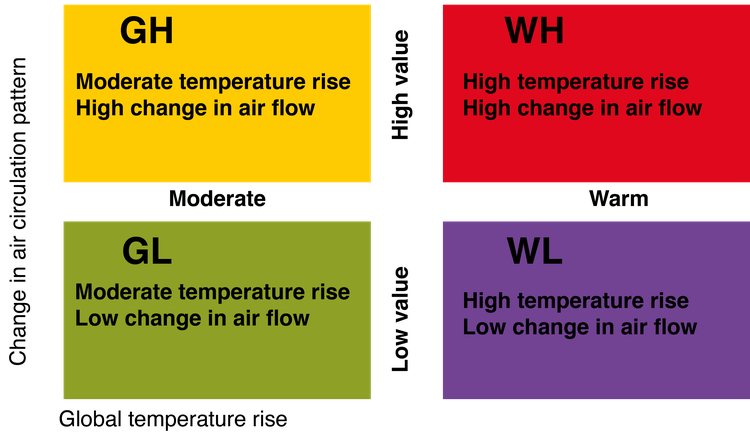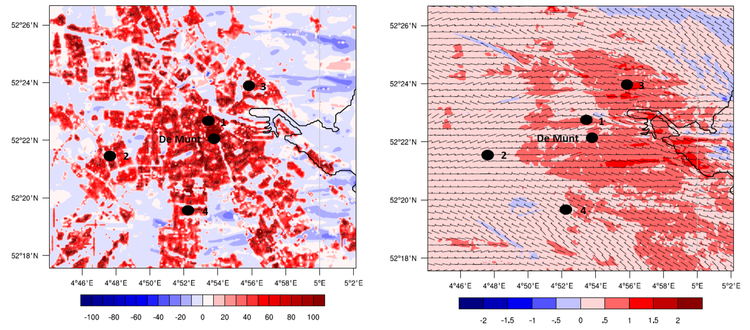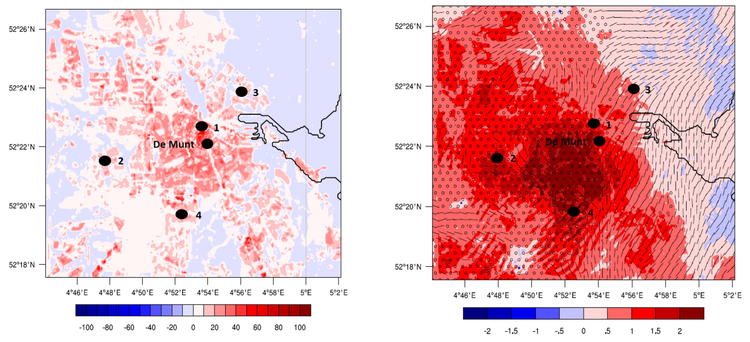Due to climate change, cities worldwide experience more extreme heat conditions. To provide insights in our future climate and the most likely developments, the Royal Netherlands Meteorological Institute (KNMI) developed four scenarios for future climate change in the Netherlands around 2050 (Figure 1).

Figure 1: Four climate scenarios for 2050 by KNMI.
“We estimated the city’s temperatures in 2050 for different scenarios using the heatwave of 2019 as our baseline. That year temperatures of more than 38 degrees Celsius were measured in Amsterdam.”
Arjan Willemse | Wageningen University & Research Alumnus & Meteorologist RTV Rijnmond
With our urban temperatures rising, it is expected that we will install more air-conditioning (AC) systems to keep our buildings cool. Although the use of air conditioning lowers the temperatures in our offices and homes, how do these systems impact our urban climate?
Researchers at Wageningen University & Research (WUR) and Amsterdam Institute for Advanced Metropolitan Solutions (AMS Institute) found that these airconditioning systems contribute to heating up the city.
Sensible heat flux and temperatures in degrees Celcius
To cool off our offices and homes, AC systems transfer heat from inside buildings to the outdoor environment. This impacts the 'sensible heat flux' - the heat transfer to the atmosphere - that ends up in our city's urban dome. This in turn results in more heat in the city and to increasing urban temperatures.
With an advanced weather forecast model - called the 'Weather Research and Forecasting' model - the researchers incorporated the effect of AC systems on our urban environment. For each of the four climate scenarios by KNMI, they simulated the effect of airconditioning systems on sensible heat flux as well as degrees Celcius.
“To cool our buildings, the AC systems use energy to transport heat from inside to outside. The transferred heat, which is moved from inside a building to outside, impacts the sensible heat flux and our outside temperatures.”
Arjan Willemse | Wageningen University & Research Alumnus & Meteorologist RTV Rijnmond

City temperatures exceed 40 ºC by 2050
Going from the mildest to hottest scenario, air conditioners have to work harder to provide the same level of cooling. Calculations show that the relative contribution to the temperature (in degrees Celsius) increases as the climate scenario develops more extreme.
For this research, the number of AC systems in the city for the current climate and the future climate were put on 100%. Firstly since studies like this one have not been done often, and this way the researchers could get a clear indication of the effect of AC systems on our city's temperatures. Secondly, in a future climate, many more buildings will be equipped with air conditioning systems, hence that the coverage in the city will be considerably higher.
The researchers found that - in comparison to our current climate - for one day the average temperature in 2050 will increase with 1.1ºC for the mildest scenario and up to 2.9ºC according to the hottest scenario (Figure 2, right).

Figure 2: Sensible heat flux from AC systems in W/m2 on the 24th of July 2019 at 16.00 local time in and around Amsterdam (left). Temperature increase due to the sensible heat flux that is pushed into the outdoor environment by AC systems at the same date and time (right).
“The calculations show that for the hottest scenario temperatures can exceed 40 ºC in Amsterdam in 2050, when a heat wave takes place in 2050 with similar temperatures like the one in 2019.”
Gert-Jan Steeneveld
Associate professor Meteorology and Air Quality
It is important to note that a part of these temperature increases is caused by the AC systems in the city, however a part is also caused by the warming of the climate in general - which also occurs without AC systems in the city.
It is therefore particularly crucial to consider the sensible heat flux related to air conditioning systems in the city (Figure 3). After all, this heat flux is what contributes to the warming of the urban environment.

Figure 3: Increase of sensible heat flux from AC systems compared to the increase of sensible heat flux to due warming for each climate scenario.
The urban heat-island creates a lid on the city
The sensible heat flow from AC systems is a lot lower at night than during the day (Figure 4, left). However, it is found that AC systems have a greater impact on the temperature at night compared to daytime (Figure 4, right).
This is due to the absence of turbulence at night and the fact that the atmospheric boundary layer is much smaller at night than during the day. As a result, there is much less volume for the heat to expand to. Add to this the fact that expansion is hardly possible due to the absence of turbulence. All heat therefore remains on the ground.

Figure 4: Sensible heat flux from AC systems in W/m2 on the 25th of July 2019 at 00.00 local time in and around Amsterdam (left). Temperature increase due to the sensible heat flux that is pushed into the outdoor environment by AC systems at the same date and time (right).
“In the evening the sensible heat flow from AC systems is a lot lower than during the day. However, what is striking is that the temperature increase due to the AC systems is higher at night versus during the day.”
Gert-Jan Steeneveld
Associate professor Meteorology and Air Quality
In other words, the heat creates a 'lid on the city' that traps air pollution in the city. To illustrate, by letting up weather balloons from Dam square in 2019 researchers measured that in the city (versus the countryside) it took longer for the heat to dissolve. At 10PM temperatures of 26.3ºC were still recorded at Dam Square, whereas the temperature measured at the same time on the countryside was a full 3ºC lower. Heat emitted by AC systems in our city will end up in that urban dome and will amplify this effect.
“It is often underestimated how much impact heat stress has on, for example, the vitality and productivity of inhabitants. Understanding the urban climate and the predictability of a city's weather profile is therefore becoming increasingly important.”
Gerben Mol
Program Developer
Climate adaptation strategies for a livable city
To keep our city livable during heatwaves in the future, climate adaptation strategies should be developed. One could think Nature Based Solutions that include adding more greenery in the city, green facades, and green roofs. Greenery results in a lower sensible heat flow.
Ventilation between buildings also plays an important role. In street canyons, where there is little wind, the heat remains, which means that these streets can become very hot. Better ventilation through the streets helps to make the living level a bit more pleasant during such heat.
Last but not least, we could look at technical solutions such as more insulation of homes and it also helps to choose lighter construction materials. These building materials have a higher albedo, which means that less heat is stored in the material. As a result, for example, buildings become less hot, AC systems have to work less hard and less heat from the AC systems ends up in the outside air.
This study builds on the weather balloon measurements in 2019 at Dam square in Amsterdam as part of the Amsterdam Atmospheric Monitoring Supersite (AAMS) project. The current findings are part of the MSc thesis by WUR Alumni Arjan Willemse and our Principal Investigator Gert-Jan Steeneveld.



